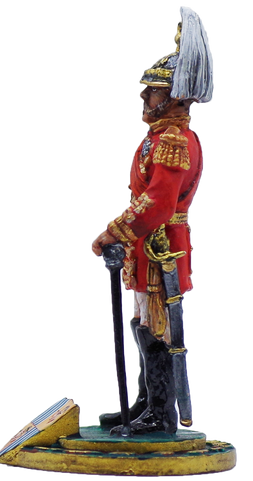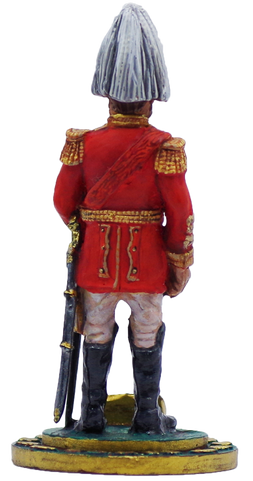
Adolf Joseph
Prince of Schwarzenberg
Adolf Joseph of Schwarzenberg, 8th Prince of Schwarzenberg (Vienna, 18 March 1832 – Libejovice, 5 October 1914), was a Bohemian nobleman, politician and entrepreneur. Adolf Joseph was born in Vienna in 1832, the son of Prince John Adolf II of Schwarzenberg and his wife, Princess Maria Eleonora of Liechtenstein. During his youth he studied philosophy in Vienna and later read in Göttingen. After graduating in 1850, he undertook military service in the imperial Austrian army, in a regiment of uhlans, taking part in the First Schleswig War in that same year. In 1856 he was appointed ambassador extraordinary of Austria at the coronation of Tsar Alexander II in Moscow. In 1858, after his wedding, he decided to leave the army but the following year he returned due to the outbreak of war in Italy. On 24 June 1859 he took part in the battle of Solferino and on 28 June of that same year he was promoted to the rank of major. At his father's wish, from 1853 he also took over the management of the forests of the domain of the princes of Schwarzenberg, continuing the work of forestry development already begun by his grandfather. The prince found himself (as his father had found himself) particularly well versed in this task and began careful management of the estates of Netolice, Protivín and Libejovice, the latter

place where he spent much of his free time. During the Universal Exhibition in Vienna in 1873, he attended with his father the presentation of the successes achieved by the Schwarzenbergs in agriculture, forestry and fish farming in southern Bohemia. After his father's death in 1888, Adolfo Giuseppe took the reins of management of his family's entire immense land heritage. A great lover of agriculture, he willingly dedicated himself to other side activities such as hunting, building distilleries, breweries and dairies. In 1892 he opened the Louny brewery which soon became one of the most modern breweries in Austria-Hungary, also involving chemists and experts to best produce beer and seek innovative nuances in taste and colour. During the period of his regency he began a vast work of cataloging and conservation of the historical monuments of southern Bohemia in which he took part due to his great interest in history (like his father), as well as being interested in archaeology, patronizing the Academy Bohemian of Sciences in his research on his lands. He was, among other things, a friend of the scholar František Palacký. On a conceptual level, as a Bohemian even before being a subject of the Austro-Hungarian crown to whom his family owed much of its fortune, Prince Adolf Joseph was a supporter of the need for good relations between Czechs and Germans, insisting however on the fact that that of authority should be preferable to the political concept of nationality, as well as a meritocratic assignment of government positions. He completely denied any manifestation of nationalism, whether on the part of the Germans or the Bohemians. For example, he refused to contribute to a monument dedicated to Emperor Joseph II in Ceský Krumlov because he considered it excessively nationalistic on the part of the Germans in a land that ultimately did not belong to them. In 1865 he was elected district governor in Vodnany. In 1872 he was elected mayor of the Netolice district, but in this second election he did not have the approval of the emperor, precisely because of his political ideas. In the provincial elections of January 1867 he became a member of the Bohemian parliament, being re-elected in August 1868, always sitting in the ranks of the conservatives, defending the rural communities of Bohemia. He continued his activity in the Bohemian Chamber until 4 December 1888 when, after the death of his father and obtaining the title of Prince of Schwarzenberg, he was hired into the upper chamber, replacing his parent in this position.

The Arcièren Bodyguard (from Italian Arciere, "archer", "bodyguard") was one of the five guard formations of the Emperor of Austria. The full name was k.k. First Arcièren Bodyguard. It consisted only of generals, staff and senior officers and, alongside the Royal Hungarian Body Guard, was the most distinguished of the Austro-Hungarian guards. Originally only semi-invalid officers of noble origin were accepted; it was only in 1807 that the Guard was open to non-nobles. The admission conditions were very strict. Good looks and a minimum height (174 cm) were required. The aspirant had to be able to point out special merits before the enemy, and if possible also injuries, which, however, were not allowed to disfigure him. He had to have an excellent job description and be skilled at riding. Unmarried people were preferred. The Catholic creed was required until 1780. The Arcièren Body Guard was not a guard in the sense of the Swiss Guard of the Vatican or the Hundred Swiss (Cent Suisses) of the French King Louis XVI, as most of its members had already reached senior age. (Colonel General Viktor Dankl von Krásnik was already 64 years old when he was appointed captain of the Arcièren Body Guard; Lieutenant Field Marshal Friedrich Karl von Fürstenwärther was only accepted on his 70th birthday.) The unit's tasks
were purely representative. It was subordinate to the First Chief Steward as the head of all the guards. In Austria-Hungary, the tasks of a guard in the military sense were the responsibility of the lifeguard cavalry squadron and the lifeguard infantry company as well as, to a limited extent, the satellite bodyguard.

The House of Schwarzenberg is a German (Franconian) and Czech (Bohemian) aristocratic family, and it was one of the most prominent European noble houses. The Schwarzenbergs are members of the German nobility and Czech nobility, and they held the rank of Princes of the Holy Roman Empire. The family belongs to the high nobility and traces its roots to the Lords of Seinsheim during the Middle Ages. The family stems from the Lords of Seinsheim, who had established themselves in Franconia during the Middle Ages. A branch of the Seinsheim family (the non-Schwarzenberg portion died out in 1958) was created when Erkinger of Seinsheim acquired the Franconian territory of Schwarzenberg and the castle of Schwarzenberg in Scheinfeld during the early part of the 15th century. He was then granted the title of Freiherr (Baron) of Schwarzenberg in 1429. At that time, the family also possessed some fiefdoms in Bohemia. In 1599, the Schwarzenbergs were elevated to Imperial Counts, and the family was later raised to princely status in 1670. In 1623 came the Styrian Dominion of Murau into the Schwarzenberg family due to the marriage of Count Georg
Ludwig of Schwarzenberg (1586–1646) with Anna Neumann von Wasserleonburg (1535–1623). Furthermore, the House of Schwarzenberg acquired extensive land holdings in Bohemia in 1661 through a marriage alliance with the House of Eggenberg. In the 1670s, the Schwarzenbergs established their primary seat in Bohemia and, until 1918, their main residence was in Ceský Krumlov, Bohemia (now in Czech Republic). At the beginning of the 19th century, the House of Schwarzenberg was divided into two princely-titled lines (majorats). This division was already foreseen in the will of Prince Ferdinand (1652-1703). However, the absence of two male heirs until Joseph II and Karl I Philipp inhibited the execution. The senior branch, which held not only the Palais Schwarzenberg in Vienna, but also the Dominions of Scheinfeld, Krumlov, Frauenberg and Murau, died out in the male line in 1979 upon the death of Joseph III of Schwarzenberg, who was the 11th Prince of Schwarzenberg. The cadet branch, which was established by Karl Philipp, Prince of Schwarzenberg at Orlík Castle, continues to the present day.
Awards: Sash and insignia of the Distinguished Order of the Golden Fleece, Star of the Imperial Order of the Iron Crown.






